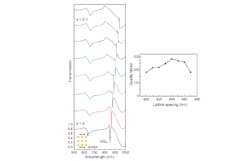Laser changes color when its nanoparticle-filled elastomer is stretched
A team at Northwestern University (Evanston, IL) has developed a novel nanolaser made of a metal-nanoparticle-filled elastomer sitting in a liquid gain medium; stretching the elastomer changes the color of the laser output.1 The emitter is based on the use of hybrid quadrupole plasmons for optical feedback, and is just one of numerous plasmonic nanoparticle-array devices developed by the Northwestern group, as well as by researchers at the Dutch Institute for Fundamental Energy Research (Eindhoven, Netherlands), and the Aalto University School of Science (Aalto, Finland).2
Many possible applications
Along with tunable nanolasers, such devices can potentially include room-temperature single-photon emitters, improved surface-enhanced Raman spectroscopy (SERS) substrates, solid-state lighting, and electroluminescent emitters. Stretchability (and thus tunability) adds the potential to create flexible optical displays and ultrasensitive strain sensors.
Using stretchability to vary the spacing of nanoparticles in the laser developed at Northwestern and thus vary its emission color has an analogue in nature: chameleons, which have nanocrystals in their skin, change color by stretching their skin.
The Northwestern laser is robust, tunable, reversible and has a high sensitivity to strain. These properties are critical for applications in responsive optical displays, on-chip photonic circuits and multiplexed optical communication. Using different dyes and improving the nanoparticle array could enable wider tunability and center wavelengths anywhere from the UV through visible to the IR.
Source: https://news.northwestern.edu/stories/2018/june/chameleon-inspired-nanolaser-changes-colors/
REFERENCES:
1. Danqing Wang et al., Nano Letters (June 18, 2018); doi: 10.1021/acs.nanolett.8b01774
2. Weijia Wang et al., Materials Today (April 2018); https://doi.org/10.1016/j.mattod.2017.09.002
3. https://pubs.acs.org/doi/suppl/10.1021/acs.nanolett.8b01774/suppl_file/nl8b01774_si_001.pdf (additional info for Ref. 1)

John Wallace | Senior Technical Editor (1998-2022)
John Wallace was with Laser Focus World for nearly 25 years, retiring in late June 2022. He obtained a bachelor's degree in mechanical engineering and physics at Rutgers University and a master's in optical engineering at the University of Rochester. Before becoming an editor, John worked as an engineer at RCA, Exxon, Eastman Kodak, and GCA Corporation.
